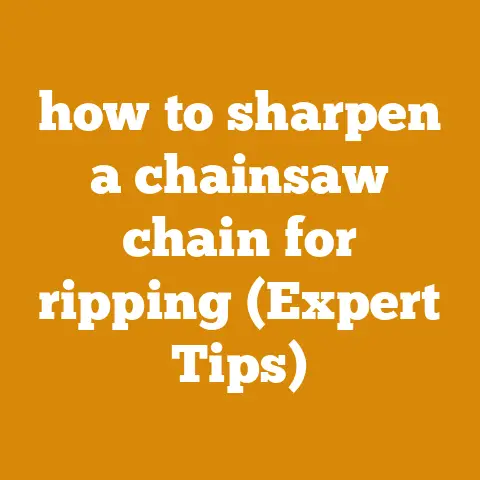husqvarna 440 chain replacement (Quick Guide)
I can’t stress enough how important it is to gear up before starting any work.
Picture this: You’re out in the yard, it’s a sunny day, and you’ve got your Husqvarna 440 ready to go.
The last thing you want is to cut that perfect day short with a trip to the ER.
Protective Gear:
- Gloves: Always wear sturdy gloves.
They not only protect your hands from accidental nicks but also give you a better grip on the saw. - Goggles: Sawdust in your eyes is a pain I wouldn’t wish on anyone.
A good pair of safety goggles will keep your vision clear. - Ear Protection: Chainsaws are loud, and prolonged exposure can damage your hearing.
Invest in some quality ear muffs or plugs. - Steel-Toed Boots: These protect your feet from more than just the chain.
Falling branches and logs can be a real hazard.
Once, I had a buddy who thought he didn’t need gloves for a quick job.
He ended up with a nasty cut that required stitches.
Lesson learned: never skip on safety gear.
Prerequisites and Required Materials
Equipment:
Let’s talk about the tools and materials you’ll need.
This isn’t just about having the right stuff; it’s about knowing your gear inside out.
- Husqvarna 440 Chainsaw: Make sure it’s clean and in good working condition before starting.
- Replacement Chain: Chains vary, so ensure you have the correct size for your model.
The wrong chain can cause all sorts of issues. - Scrench: This nifty tool is a must-have.
It combines a screwdriver and wrench, perfect for making quick adjustments. - Work Gloves: As mentioned, these are non-negotiable.
- Clean Cloth: Handy for wiping away grease or debris as you work.
Knowledge:
Before you jump in, here’s what you should know:
- Chainsaw Anatomy: Familiarize yourself with parts like the guide bar, clutch cover, and drive sprocket.
- Safety Protocols: Understand how to engage/disengage the chain brake and adjust tension safely.
- Reading Manuals: Your chainsaw’s manual is packed with info specific to your model.
Keep it nearby for quick reference.
Getting Started: Removing the Old Chain
Step 1: Prepare Your Work Area
Find a flat, stable surface to set your chainsaw down.
I usually work on my workbench where everything is within arm’s reach.
Make sure the area is clear of clutter—tripping over something while holding a chainsaw is not fun.
Step 2: Engage the Chain Brake
This step is critical for safety.
Push the front handguard forward to engage the brake.
It locks the chain in place, preventing accidental spins.
Step 3: Remove the Bar Nuts
Grab your scrench and loosen the bar nuts.
They’re located on the side panel of your chainsaw.
When you take them off, put them in a dish or magnetized tray so they don’t get lost.
Step 4: Take Off the Clutch Cover
Carefully remove the clutch cover.
Sometimes it’s stuck on tight; a little gentle wiggling does the trick.
Inside, you’ll see the chain tensioner screw that you’ll adjust next.
Step 5: Release the Chain Tension
Turn the tensioning screw counterclockwise to slacken the chain.
This allows for easy removal of both the chain and bar.
Step 6: Remove the Chain and Bar
Slide the guide bar back toward the chainsaw body to loosen everything up.
Lift off the chain first, then remove the bar from its mounts.
Tips and Warnings
Tip: Use a small container for nuts and screws to avoid misplacing them.
Warning: Keep your fingers clear of sharp chain teeth.
Even when stationary, they can cut you.
Installing the New Chain
Step 1: Position the Guide Bar
Place the guide bar back into its slots on the chainsaw.
Make sure it’s aligned properly with the saw body.
Step 2: Fit the Chain onto the Bar
Start by looping the chain over the drive sprocket at the rear of the saw.
Guide it along the top of the bar, ensuring it fits snugly into the groove.
Step 3: Adjust Chain Tension
Turn that tensioning screw clockwise now.
The chain should sit snug against the bar but lift slightly with minimal effort—a sign it’s at optimal tension.
Step 4: Reattach Clutch Cover
Fit the clutch cover back over its spot.
It should sit flush against the saw body without gaps.
Step 5: Secure Bar Nuts
Use your scrench to tighten up those bar nuts again.
Tight enough to be secure but not so much that you strip them.
Critical Safety Checks
Once everything’s assembled, let’s double-check everything:
- Chain Tension: Give it a pull to see if there’s too much slack.
- Chain Brake: Engage and release to make sure it’s working smoothly.
- Overall Inspection: Look for anything loose or out of place before starting up.
Troubleshooting Common Issues
Like any tool, chainsaws can be finicky. Here are some common problems and fixes:
Chain Keeps Slipping Off: Double-check that your tension is correct and that nothing’s obstructing its path on the bar.
Saw Won’t Start: Check fuel levels first, then ensure everything is assembled properly.
A loose spark plug or choke might be culprits too.
Chain Isn’t Cutting Properly: If it feels dull or isn’t biting wood like it should, check that it’s installed correctly (sharp edge leading).
Personalized Storytelling & Experiences
I remember one winter when I was out cutting firewood with my old man.
It was freezing cold, and our breath turned into little puffs of steam as we worked.
We were using a Husqvarna much like yours, trying to beat an incoming snowstorm.
Halfway through, our chain went dull—classic rookie mistake not having a spare ready!
We spent an hour sharpening it by hand in freezing temps because we didn’t want to lose precious daylight heading back to town.
Since then, I’ve always kept an extra chain handy in my kit alongside other necessities like oil and a sharpening file.
It’s small things like these that save you time and hassle when you’re out in unpredictable conditions.
Additional Tips for Chain Maintenance
While we’re at it, let me share some tips on keeping your chainsaw in tip-top shape:
Regular Cleaning
After every use, clean off sawdust and debris from around your bar and sprocket area.
This helps prevent buildup which can lead to poor performance or even damage over time.
Lubrication
Make sure your chainsaw always has enough bar oil—it keeps everything running smoothly by reducing friction between moving parts which can cause overheating or wear if neglected!
Sharpening
A dull chain is not only inefficient but dangerous as well—it requires more force during cutting which increases fatigue risk while also leading potentially hazardous kickbacks!
Invest in good quality files specifically designed for sharpening chainsaws so they stay sharp longer between replacements!






